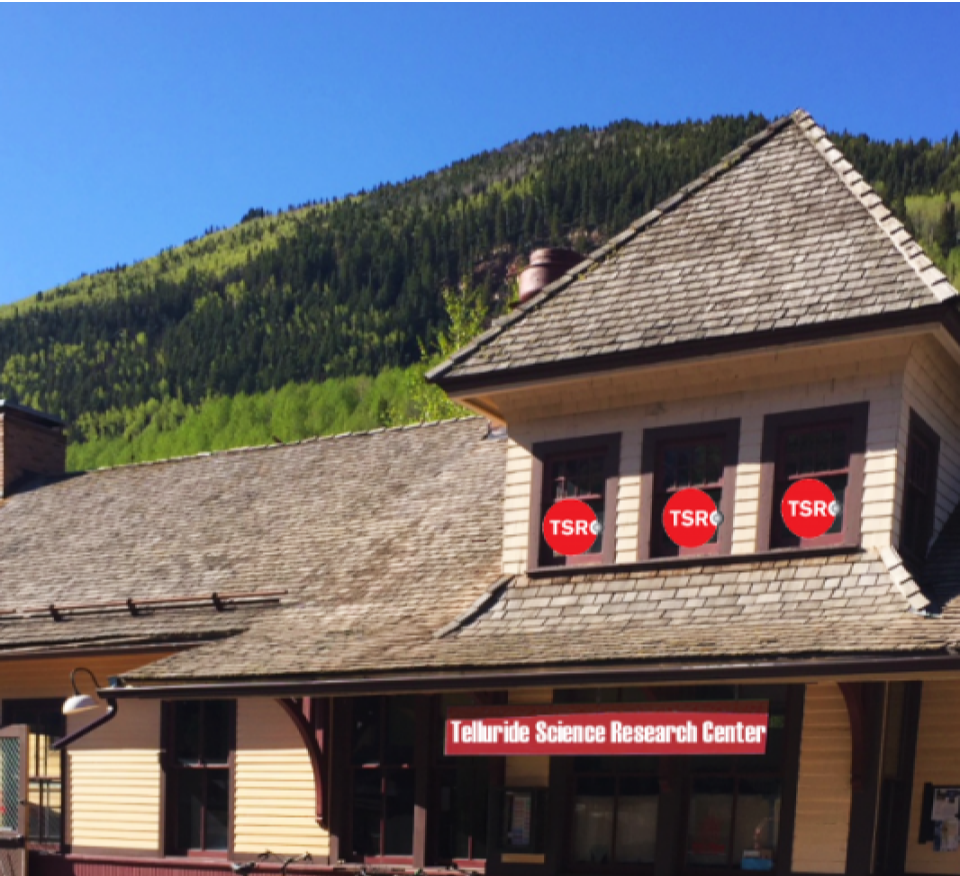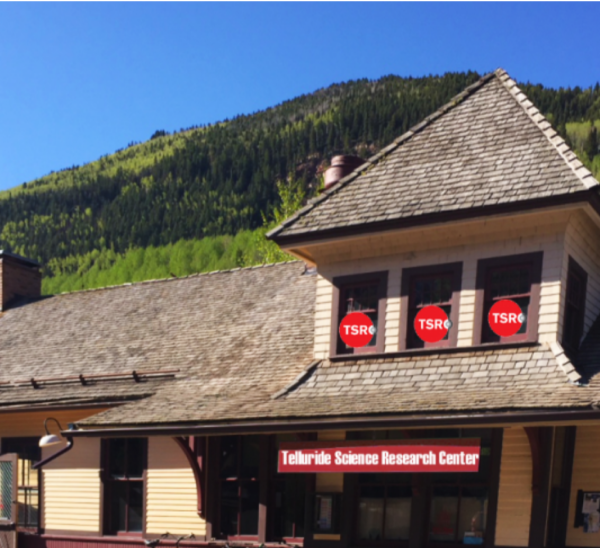
06 Jun Telluride Science: Scientists Return + Town Talks Start Up Again 6/8!
Telluride Science welcomes their esteemed scientists back to Telluride this week. Town Talks return with a new venue and a new format.
The Telluride Science Town Talks move to the Town of Telluride for the summer of 2021. The doors of the Telluride Transfer Warehouse will open at 6pm on Tuesday, June 8th in preparation for a panel discussion. The program features three extraordinary scientists,: Anna Marie Pyle of Yale University; Forest Rohwer of San Diego State University, and Yogi Surendranath of MIT, who will take on questions about the future of science and how it will impact all of our lives. The program, “It’s Going to Get Weird Fast: the revolutions in science and tech that are happening right under our noses,” will begin at 6:30pm.
For more on Telluride Science and The Depot, go here.

While last year’s Telluride Science workshops were virtual due to COVID-19, this summer will be a mix of virtual and in-person meetings from June 7 through July 30. Travel restrictions have hampered a full return of the world-renown, invitation-only scientist programming, but 2022 is slated to be the busiest year ever for Telluride Science with every summer week fully booked.
This year, 2021 ,will bring back the popular Telluride Science Town Talk series for the local community, though this summer will feature a new format in a new venue.
The public talk series was started in 1991 by Telluride Science Research Center co-founders, Stephen R. Berry and Peter Salamon, with the intent to engage the community with some of the extraordinary science that occurs at local workshops. The talks are free and geared towards the lay people in the community.
Past talks include “Lead us not into Hemptation: The Genetics of American Cannabis,” “The Science and Mysteries of Alzheimer’s Disease,” and “Getting to Zero: How fast can we reduce carbon emissions?”
This summer, the talks are scheduled to take place outside at the Telluride Transfer Warehouse, and rather than one-scientist presentations, the programs will include panels of visiting scientists along with moderators, Judy Muller and George Lewis, both award-winning journalists.
The series kicks off on June 8th with “It’s Going to Get Weird Fast: the revolutions in science and tech that are happening right under our noses.”
Veteran journalists Muller and Lewis will guide the conversation with Anna Marie Pyle, President of the RNA Society and Sterling Professor of Molecular, Cellular & Developmental Biology and a Professor of Chemistry at Yale University,; Forest Rowher, marine microbial ecologist and Professor of Biology at San Diego State University; and Yogesh Surendranath, Associate Professor of Chemistry at MIT and collaborator of the MIT Energy Initiative.
“The panel will address the coming obsolescence of tech and systems that we’ve counted on for generations,” Managing Director Cindy Fusting explained. “From how we treat and prevent disease to how we create, store and use energy to the basic operations of our economy – the implementation of new tech will change our landscape and how we function within it.”
Town Talks have always been a great way for scientists to interact with the community.
“This year’s format will allow for even more audience engagement and opportunities for personal conversations between our scientists and members of the public,” noted Fusting. “Our scientists enjoy having conversations with the community, and they often remark on the importance of the warm welcome and support they receive in Telluride.
“I’m incredibly impressed by the support that members of the Telluride community have given to Telluride Science over the years,” Pyle concurred. “I’ve never teamed up with a group of just citizens who care and who want to do what they can to advance science. It’s wonderful to meet people like that, and I’m really grateful.”
The connection between the scientists and the Telluride community is an important part of the success of Telluride Science.
“Invariably, scientists tell us each week how they had a lightbulb moment on a hike or how they met an interesting local on the gondola,” continued Fusting. “You can’t quantify the value of these experiences, but they are no doubt a big part of the special sauce that makes us different.”
And, what is it that makes Telluride Science different?
The Telluride Science Research Center was founded in 1984 by Berry and Salamon to serve as an incubator for molecular science. At the time, the town of Telluride was an off-the-beaten-path dot on the map known only to insiders.
“Very few people came there,” Ron Naaman, a Telluride Science veteran, and currently professor of chemical and biological physics at the Weizmann Institute of Science in Israel, recounted. “Telluride was really a remote place. It was the end of the road of everything.”
Since then, Telluride has become a popular tourist destination, known primarily as a ski resort with noteworthy cultural vibrancy. But as Telluride Science’s reach continues to grow – each year attracting over 1,400 scientists from their network of 5,000 – the town has become a hub for science.
• Supercomputing programs that can design drug treatments.
• A series of electrochemical reactions that could potentially generate more clean energy.
• A sequencing technique that can analyze the genetic material of thousands of uncultured viruses at a time.
Though seemingly unconnected, the brains behind these breakthroughs – along with Nobel Prize-winning others – have one thing in common. The scientists attached to those discoveries have spent years, if not decades, collaborating at the Telluride Science Research Center.
Every summer, scientists travel from around the world to attend the annual summer workshops. Topics under discussion range from how to harness solar energy to the mechanisms of cystic fibrosis and the structure and applications of nucleic acids like DNA.
Many workshops have inspired important scientific breakthroughs with organizers going on to win awards and national recognition for work that began in our box canyon.
In 2013, workshop attendee Arieh Warshal shared the Nobel Prize in Chemistry with Michael Levitt and Martin Karplus for their work creating computer models for biological systems.
The following year, Telluride Science participant William Moerner won the Nobel Prize in Chemistry (alongside Eric Betzig and Stefan W. Hell) for the first high-resolution detection of a single molecule.
And in 2017, workshop organizer and Harvard University Professor Prineha Narang made it onto Forbes’ “30 under 30” list for her work with quantum sensing technologies or devices that can detect the tiniest of molecules.
The real magic of Telluride Science stems from intimate discussions among scientists.
“It’s always really wonderful to spend some time in Telluride and hear people being able to give the story of what they’ve been thinking about in some detail and depth, and engage with them as to how they might do their work better and how it intersects with yours,” said Ron Cohen, a professor of chemistry and earth and planetary science at University of California-Berkeley.
As Cohen explained, the informal, intimate nature of the workshops allow for a meaningful experience.
“When you have a meeting with a small number of people for that week, you develop trust and engagement that’s hard to achieve when you’re in a bigger room. By the end of the week, the conversation is much more free flowing than otherwise. I always go away invigorated and often wishing someone else’s project was mine and that I thought of it myself, or more excited about what I’m doing because other people in the room were excited about it,” Cohen said.
But it’s not just within the walls of these workshops that these discussions occur. Telluride Science workshops have a unique format that blends structured classroom time with relaxed group activities including local hikes and outdoor conversations to provide scientists with many avenues for important connections and constructive collaboration.
“The collegial atmosphere, the fantastic environment, and the hikes that you do, it all brings about a dimension that makes it easy to envision new ways to collaborate,” Sylvie Roke, professor at École Polytechnique Fédérale de Lausanne in Switzerland, said. “Telluride Science collaborations are often very successful and, in my case, long-lasting.”
Another distinction of Telluride Science workshops are their propensity to spawn collaborations between people from different scientific backgrounds. By bringing together experts from distinct disciplines, each person adds a new perspective to the table and contributes to lively conversations that often lead to breakthrough projects.
For example, the “YAP/TAZ and TEAD: At the Crossroads of Cancer” workshop is organized by anesthesiologist Guy Weinberg and researchers John Lamar and Bob Varelas. Since the workshop’s start in 2017, the group has met every year to discuss the biological mechanisms of epithelioid hemangioendothelioma (EHE), a rare form of cancer that afflicts one in a million people worldwide —including Weinberg’s son. As both Lamar and Weinberg explained, the Telluride workshops have been incredibly instrumental in advancing EHE research.
“The discussions in Telluride have really shed a lot of light on this disease,” Lamar, a researcher at Albany Medical College, explained. “There’s no way my lab would have started working on this disease if it weren’t for the workshop. EHE research has been fast-tracked because we have all these other people thinking about it, even if they’re just giving us ideas at the workshop.”
“The Telluride Science Research Center has been spectacularly successful not only for me personally, but in terms of advancing our knowledge of EHE,” Weinberg added. “Two labs have now developed animal models for EHE. They’re different models, but they are both very, very robust and interesting.”
Future of Telluride Science
Telluride Science’s impact will soon be amplified as a result of the recent acquisition of a permanent home in the form of the historical Telluride Depot.
The Depot will allow for more flexibility and a year-round expansion of the organization’s operations. Over the years and even now, Telluride Science only has access to rent the school district’s facilities for seven weeks in the summer.
Telluride Science purchased the Depot, previously occupied by the Ah Haa School for the Arts, in October of 2020. Because there was a need for an auxiliary respiratory clinic during the pandemic, Telluride Science postponed plans for the building’s renovation . The Telluride Medical Center is currently leasing the space.
“Owning the Depot will allow TSRC to address our ever-expanding demand from the science community, while optimizing the experience throughout the entire year,” Executive Director Mark Kozak explained in a previous Telluride Inside and Out article. “Having a home of our own for a year-round programming space to host both science and innovation workshops will also further amplify Telluride’s reputation as a global driver in generating ideas and solutions that address some of society’s and the planet’s most critical challenges.”


Sorry, the comment form is closed at this time.